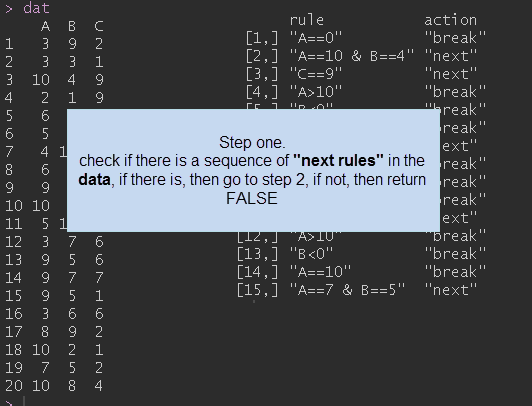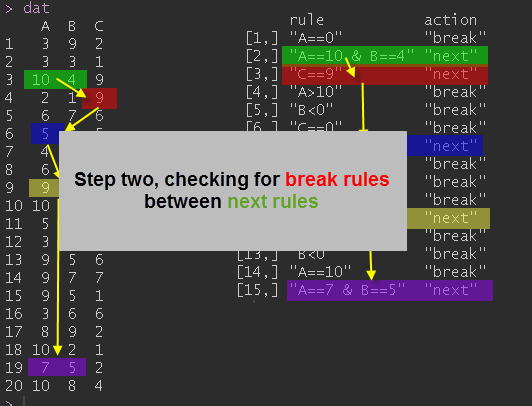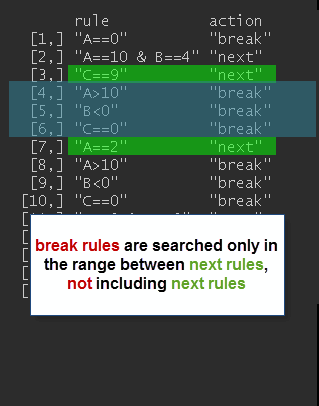I showed how I see the implementation of this algorithm, I divided it into two steps
step one sequence search

step two check break rules

set.seed(123)
dat <- as.data.frame(matrix(sample(10,60,replace = T),ncol = 3))
colnames(dat) <- LETTERS[1:ncol(dat)]
dat
rule <- c("A==0","A==10 & B==4","C==9","A>10","B<0","C==0","A==5","A>10",
"B<0","C==0","A==9 & B==9","A>10","B<0","A==10","A==7 & B==5")
action <- c("break","next","next",rep("break",3),"next",rep("break",3),
"next",rep("break",3) ,"next")
rule <- cbind(rule,action)

I think this works -
seq_rule <- function(dat, rule, res.only = TRUE) {
value = rule$action
rule <- rule$rule
m <- with(dat, lapply(rule, function(r) eval(str2expression(r))))
fu <- function(x, y) {
k <- which(y)
ifelse(all(k <= x), NA, min(k[k > x]))
}
idx <- Reduce(fu , m,init = 0, accumulate = TRUE)[-1]
if (!res.only) {
idx <- na.omit(idx)
fidx <- head(idx, length(rule))
debug.vec <- replace(rep("no", nrow(dat)), fidx, rule[seq_along(fidx)])
return(cbind(dat, debug.vec))
}
if(any(value[!is.na(idx)] == 'break')) return(FALSE)
idx <- na.omit(idx)
length(idx) >= length(rule)
}
Here are some checks -
rule <- data.frame(rule= c("A==9","B==4","C==4","A==4", "B==10","C==4") ,
action= c(rep("next",3),"break","break","next"))
seq_rule(dat = dat,rule = rule)
#[1] FALSE
rule <- data.frame(rule= c("C==9","B==3","C==4"),
action= c(rep("next",3)))
seq_rule(dat = dat,rule = rule)
#[1] TRUE
seq_rule(dat = dat,rule = rule, res.only = FALSE)
# A B C debug.vec
#1 3 5 9 C==9
#2 3 3 3 B==3
#3 10 9 4 C==4
#4 2 9 1 no
#5 6 9 7 no
#6 5 3 5 no
#7 4 8 10 no
#8 6 10 7 no
#9 9 7 9 no
#10 10 10 9 no
rule <- data.frame(rule= c("C==9","B==3","C==4", "A == 1"),
action= c(rep("next",3), 'break'))
seq_rule(dat = dat,rule = rule)
#[1] FALSE
rule <- data.frame(rule= c("C==9","B==3","C==4", "A == 6"),
action= c(rep("next",3), 'break'))
seq_rule(dat = dat,rule = rule)
#[1] FALSE
Since the logic of your question is a bit complicated, I guess a straightforward way, e.g., using loops, might be more efficient and readable. Here is one version of seq_rule
seq_rule <- function(dat, rule, res.only = TRUE) {
m <- with(dat, as.data.frame(sapply(rule$rule, function(r) eval(str2expression(r)))))
rule_next <- with(rule, rule[action == "next"])
m_next <- m[rule_next]
idx <- na.omit(
Reduce(
function(x, y) {
k <- which(y)
ifelse(all(k <= x), NA, min(k[k > x]))
}, m_next,
init = 0, accumulate = TRUE
)
)[-1]
fidx <- head(idx, length(rule_next))
debug.vec <- replace(rep("no", nrow(dat)), fidx, rule_next[seq_along(fidx)])
trgs <- do.call(
rbind,
Map(
function(p, q) {
u <- as.matrix(m[p, ][q[q %in% with(rule, rule[action == "break"])]])
k <- which(u, arr.ind = TRUE)
data.frame(breakRowID = row.names(u)[k[, "row"]], breakTrigger = colnames(u)[k[, "col"]])
},
split(1:nrow(dat), cut(1:nrow(dat), c(0, idx, Inf))),
split.default(names(m), cumsum(rule$action != "break"))
)
)
triggerBreaks <- replace(rep("no", nrow(dat)), debug.vec != "no", NA)
if (!res.only) {
cbind(dat, debug.vec, trigger.break = with(trgs, replace(triggerBreaks, as.numeric(breakRowID), breakTrigger)))
} else {
nrow(trgs) == 0
}
}
and you will see
> seq_rule(dat = dat, rule = rule)
[1] FALSE
> seq_rule(dat = dat, rule = rule, res.only = FALSE)
A B C debug.vec trigger.break
1 3 9 2 no no
2 3 3 1 no no
3 10 4 9 A==10 & B==4 <NA>
4 2 1 9 C==9 <NA>
5 6 7 6 no no
6 5 5 5 A==5 <NA>
7 4 10 9 no no
8 6 7 10 no no
9 9 9 4 A==9 & B==9 <NA>
10 10 9 6 no A==10
11 5 10 8 no no
12 3 7 6 no no
13 9 5 6 no no
14 9 7 7 no no
15 9 5 1 no no
16 3 6 6 no no
17 8 9 2 no no
18 10 2 1 no A==10
19 7 5 2 A==7 & B==5 <NA>
20 10 8 4 no no
If you love us? You can donate to us via Paypal or buy me a coffee so we can maintain and grow! Thank you!
Donate Us With